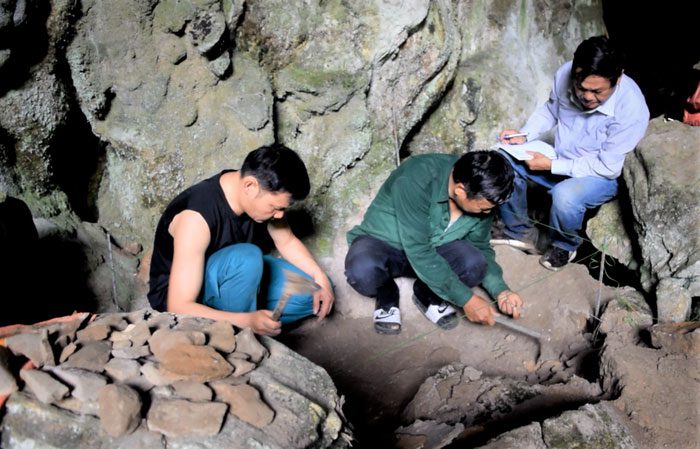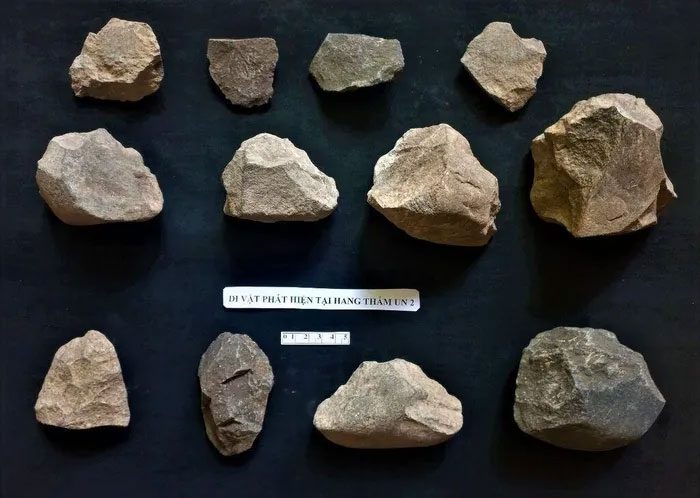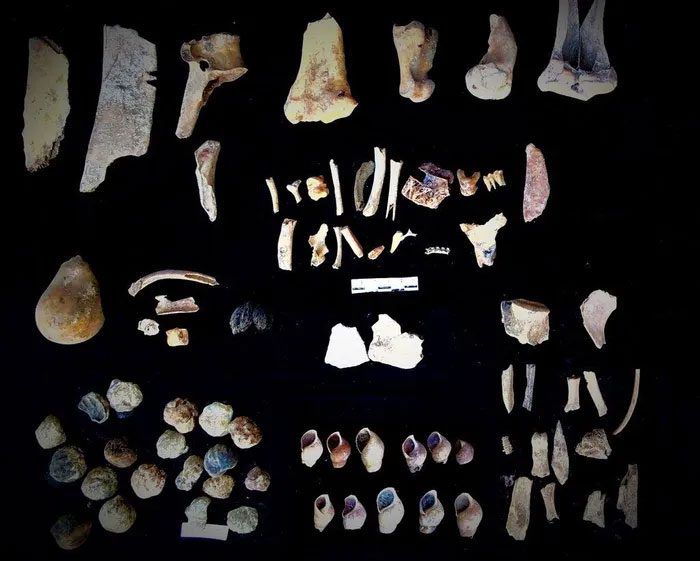The archaeological team from the Vietnam Academy of Social Sciences, in collaboration with the Bac Kan Provincial Museum, recently conducted excavations at Nam Lu Cave (Hoang Tri Commune), Tham Pan Cave, and Tham Un 2 Cave (Quang Khe Commune, Ba Be District). They discovered nearly 200 archaeological artifacts, primarily stone tools, bones, and pottery, dating back approximately 8,000 to 10,000 years.

Excavation at Tham Un 2 Cave. (Photo: TTXVN).
According to Associate Professor Dr. Trinh Nang Chung from the Vietnam Academy of Social Sciences, traces of prehistoric humans were found throughout the caves. The archaeological artifacts were mixed with mollusk shells and animal teeth. Pottery was found in the upper layers. In the excavation pit, archaeologists also uncovered traces of two ancient hearths, but no burial sites have been discovered yet.
The team found an oval-shaped flat stone with a hole drilled at one end. The round hole has a diameter of 0.4 cm. Archaeologists believe this may be jewelry that was strung to be worn around the neck. Such artifacts are still quite rare in prehistoric sites in Vietnam. Although no grinding tools were found, the discovery of a grinding stone in the excavation pit indicates that ancient inhabitants were familiar with grinding techniques. The presence of many pebbles, raw materials, stones with chipping marks, and flake tools demonstrates that the process of tool making was conducted on-site.
Most stone tools were crafted from river pebbles. The types of tools obtained from the excavation pit are characteristic of early Neolithic cultural tools, including disc-shaped tools, oval tools, short axes, bifacial cutting tools, scrapers, and knives made from large flakes, grinding stones, and pestles…

Stone artifacts at Tham Un 2. (Photo: TTXVN).
The archaeologists collected many animal tooth fragments. Analysis of the animal bone remains preliminarily identified wild boar, monkeys, porcupines, jungle fowl, bamboo rats, and deer… The mollusk remains primarily consist of river snail shells, mountain snails, clams, and some plant remains such as nutmeg and tamarind seeds… The discovery of many animal tooth fragments and mollusk shells, along with remaining plant traces, indicates that hunting and gathering were crucial for the food sourcing methods of prehistoric people in this area. The presence of grinding stones and pestles is evidence that food processing often took place near cooking fires.
The pottery found at the cave entrance consists of fragments from various shapes, made from a clay body with little plant residue, high firing temperature, thin and hard ceramic body, crafted using a potter’s wheel with decorative patterns including fine cordmarks, incised lines with short parallel lines, and small circular imprints. Some pottery fragments show signs of black smoke on the exterior, indicating they may have been used for cooking. Based on the crafting techniques and decorative patterns, these pottery fragments are characteristic of Bronze Age ceramics dating back approximately 3,000 to 2,500 years.

Animal tooth fragments and mollusk shells. (Photo: TTXVN).
Associate Professor Dr. Trinh Nang Chung stated that based on the comprehensive study of the artifacts found in the caves and the structure and age of the cultural sediment layers, researchers initially believe that Tham Un 2 Cave was a habitation site for multiple generations of prehistoric people. The earliest inhabitants belong to the early Neolithic period, dating back from 8,000 to 10,000 years ago. There was a significant gap of several thousand years during which the site was uninhabited. Additionally, around 3,000 to 2,500 years ago, Bronze Age inhabitants lived here for a short period, leaving behind traces of their presence through pottery artifacts. The Tham Un 2 site holds significant historical, cultural, and scientific value.
Tham Un 2 Cave is approximately 20 meters above the mountain base. The cave entrance has a large arch shape facing southeast. In front of the entrance is a large valley with a stream flowing through it. The cave’s interior covers an area of about 100 square meters. Most of the cave’s interior receives natural light, making it very suitable for prehistoric habitation.
Specialized agencies are planning to excavate the Nam Lu and Tham Pan cave sites in the near future.


















































